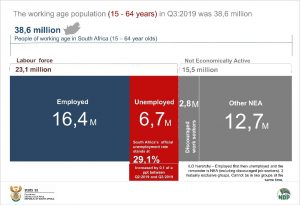
Unemployment rises slightly in third quarter of 2019
South Africa’s unemployment rate increased by 0,1 of a percentage point to 29,1% in Q3 of 2019. According to the Quarterly Labour Force Survey (QLFS) released by Statistics South Africa, this is the highest unemployment rate since Stats SA started measuring unemployment using the QLFS in 2008.
Between Q2: 2019 and Q3: 2019, the number of employed persons increased in four of the ten industries, with the largest increase recorded in the Community and social services industry (56 000), followed by Agriculture and Mining with 38 000 each and Private households (35 000). Declines in employment were recorded in the Manufacturing (30 000), Construction (24 000), Trade (21 000) and Utilities (18 000) industries.
Compared to the same period last year, a net decline of 5 000 in total employment was largely due to decreases in the number of people employed in Construction (163 000), Utilities (23 000) and Transport (21 000) in Q3: 2019 and employment gains in Trade (103 000) and Manufacturing (41 000) during the same period.
Employment increased in five of the ten occupations in Q3: 2019 compared to the previous quarter. The largest increase was observed in Professional occupations (up by 122 000), followed by those in Sales and services (up by 89 000) and Elementary (up by 38 000) occupations. Manager occupations (92 000) recorded the largest employment losses, followed by Craft and related trade (45 000), Plant and machine operator (43 000) and Technician (41 000) occupations, while Clerical occupations recorded the lowest decrease of 12 000 jobs.
The largest employment increase was observed in the formal sector (43 000), followed by the Agriculture and Private household sectors with 38 000 and 35 000, respectively. Employment in the informal sector, on the other hand, declined by 53 000 in Q3: 2019 compared to Q2: 2019.
According to the survey, the number of discouraged work-seekers increased by 44 000 while the number of people who were not economically active for reasons other than discouragement decreased by 35 000 between the second and the third quarters of 2019, resulting in a net increase of 9 000 in the not economically active population.
Compared to a year ago, total employment decreased by 5 000, the number of unemployed persons increased by 8,4% (524 000), and the number of persons who were not economically active increased by 0,5% (78 000).
The number of employed persons increased by 62 000 to 16,4 million in Q3: 2019, with the number of unemployed persons also showing an increase of 78 000 to 6,7 million compared to Q2: 2019, resulting in an increase of 141 000 (up by 0,6%) in the number of people in the labour force. The working-age population (15–64 years) in Q3: 2019 was 38,6 million.
Year-on-year changes show that losses in employment were mainly driven by Craft and related trade occupations (106 000), followed by Elementary (55 000), Plant and machine operator (39 000) and Technician (4 000) occupations. Sales and services (124 000), Domestic worker (43 000), Professional (13 000), Clerk and Skilled agriculture (7 000 each) and Manager (5 000) occupations recorded gains in employment in Q3: 2019 compared to Q3: 2018.
For more information on unemployment in South Africa, download the full report here.


